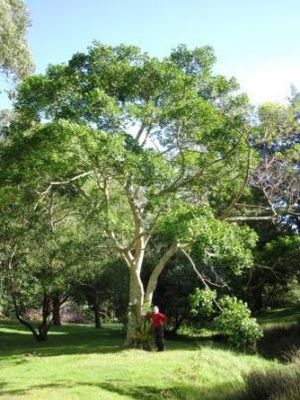Hairy-leaved doughwood facts for kids
Quick facts for kids Hairy-leaved doughwood |
|
|---|---|
 |
|
| Melicope micrococca | |
| Scientific classification | |
| Genus: |
Melicope
|
| Species: |
micrococca
|
| Synonyms | |
|
|
The Melicope micrococca, often called hairy-leaved doughwood or white euodia, is a type of shrub or thin tree. It belongs to the Rutaceae family, which includes citrus plants. This plant is special because it grows only in eastern Australia. It has leaves made of three parts and white flowers that grow in clusters.
What it Looks Like
The hairy-leaved doughwood can be a shrub or a tree. It usually grows to be about 24 to 27 meters (about 79 to 89 feet) tall. The widest part of its trunk can be around 60 centimeters (about 24 inches) across.
Its trunk is quite smooth and light brown. Older trees might have some bumpy parts near the bottom. The leaves grow in pairs on opposite sides of the stem. Each leaf has three smaller leaflets.
These leaflets are shaped like an egg, wider at the top and narrower at the bottom. They are usually 25 to 130 millimeters (about 1 to 5 inches) long. They are also 12 to 50 millimeters (about 0.5 to 2 inches) wide. The two side leaflets attach directly to the main leaf stalk. The leaflet at the end has a small stalk of its own, 3 to 13 millimeters long.
If you hold a leaflet up to the light, you can see tiny dots. These are oil dots. The underside of the leaflets is a lighter green color.
The flowers grow in groups called panicles, which are 25 to 100 millimeters (about 1 to 4 inches) long. They usually appear where the leaves meet the stem. Each flower has both male and female parts. The sepals, which are small leaf-like parts at the base of the flower, are 1 to 1.5 millimeters long. The white petals are 3.5 to 5 millimeters long. There are also four stamens, which produce pollen.
This tree flowers from November to February. After flowering, it produces fruit. Each fruit is made of up to four small pods called follicles. These pods are 4 to 5 millimeters long and are joined together at their base.
How it Got its Name
The hairy-leaved doughwood was first officially described in 1859. A scientist named Ferdinand von Mueller gave it the name Euodia micrococca. He wrote about it in his book, Fragmenta phytographiae Australiae. He studied a plant sample found near Cabramatta, New South Wales by William Woolls.
Later, in 1990, another scientist named Thomas Gordon Hartley changed its name. He renamed it Melicope micrococca in a science journal called Telopea.
Where it Lives
The Melicope micrococca usually grows in rainforests. You can find it from areas close to the sea up to mountains about 1050 meters (about 3,445 feet) high.
Its natural home stretches along the eastern coast of Australia. This includes areas from Seven Mile Beach, New South Wales in the south to Maryborough, Queensland in the north.
Ecology and Life Cycle
Many different birds enjoy eating the fruit of the hairy-leaved doughwood. These birds include the brown cuckoo dove, crimson rosella, green catbird, and Lewin's honeyeater.
This tree is also a favorite for many insects. Some butterflies, especially those in the Papilionidae family, are attracted to it.
See also
 In Spanish: Melicope micrococca para niños
In Spanish: Melicope micrococca para niños


